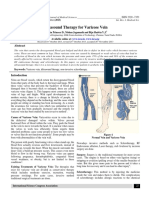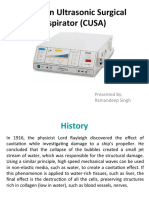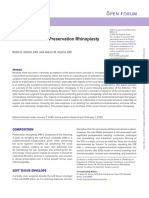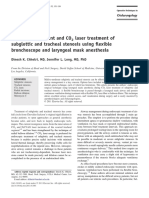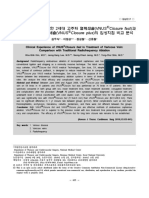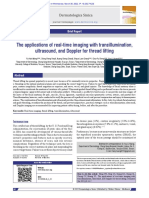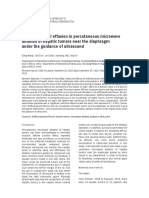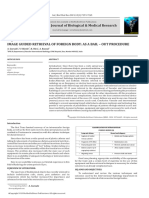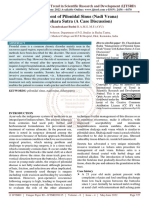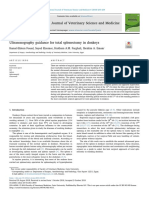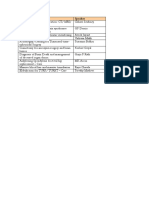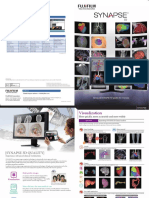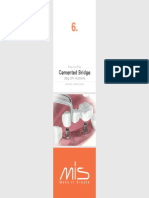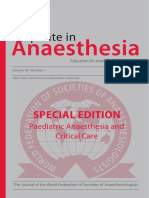Professional Documents
Culture Documents
Cusa (Cavitron Ultrasonic Surgical Aspirator) "The New Armour of Periodontal Therapy"
Original Title
Copyright
Available Formats
Share this document
Did you find this document useful?
Is this content inappropriate?
Report this DocumentCopyright:
Available Formats
Cusa (Cavitron Ultrasonic Surgical Aspirator) "The New Armour of Periodontal Therapy"
Copyright:
Available Formats
Volume 7, Issue 7, July – 2022 International Journal of Innovative Science and Research Technology
ISSN No:-2456-2165
Cusa (Cavitron Ultrasonic Surgical Aspirator)
“The New Armour of Periodontal Therapy”
Dr. Ankita sharma1, Dr. Shailendra S. Chauhan2, Dr. Aditya Sinha3, Dr. Satendra sharma4,
Dr. Vineeta gupta5, Dr. Gaurav singh6, Dr. Ritu Agrawal7
MDS1,6,7, Prof. and Head of Department2, Reader3,4,5.
Abstract:- The CUSA is a device of modern periodontal The flap's preservation of interdental space while
treatment that claims to be a breakthrough in minimal lowering vertical release permits adhesion and maturation
invasion surgical technique. While repairing a ship's with little harm, and primary purpose wound closure enables
propeller in 1916, scientist Lord Rayleigh discovered the the regeneration of periodontal tissue.
effect of cavitation. This device, like others, uses low
frequency ultrasonic radiation to dissect or split tissues In this context, further current research that defines and
with low fibre content. Ultrasonic pulses in the 23 kHz contrasts the effectiveness of the minimally invasive
range are used to create cavitations in tissue a hollow 3 nonsurgical method (MINST) and the minimally invasive
mm tip vibrating at 23,000 times per second delivers this surgical approach is necessary. Extensive subgingival
mechanical energy. debridement is the aim of MINST while keeping the
preoperative gingival architecture, making a small incision,
CUSA is a surgical device that was developed for and delicately manipulating the soft and hard tissues to
ophthalmology but has since gained widespread encourage the creation of a stable blood clot by spontaneous
acceptance in a number of medical disciplines, including filling of the infrabony defect3, 4.
neurosurgery, general surgery, gynaecology, urology, and
neurotology. This equipment cause, Biofilm disruption CUSA was originally designed for ophthalmological
and cell stimulation for non-surgical treatment of surgery, but it has since gained widespread acceptance in a
infrabony defects, as well as ultrasonic debridement and variety of medical disciplines, including neurosurgery,
flapless therapy, are said to be effective. general surgery, gynaecology, urology, neurotology, and,
most recently dentistry5-6 (figure: 1). A well-known medical
Using this aspirator increases safety and quality tool called the Cavitron ultrasonic surgical aspirator (CUSA)
while decreasing operational time. There are no known is utilised for many different conditions, the most frequent of
contraindications, but there are financial and personal which being liver illness and neurosurgery. Cell stimulation
constraints. As a result, this strategy appears to be a and biofilm eradication have both been successfully
viable option for improving non-surgical minimally accomplished with CUSA. CUSA's capacity to disrupt,
invasive therapeutic procedures. rupture, and aspirate granulation tissue is claimed to increase
the size and stability of blood clots when used for nonsurgical
Keywords:- Cavitron Ultrasonic Surgical Aspirator, Pocket healing of infrabony lesions7.
Depth, Non-Surgical Periodontal Therapy, Infrabony Defects
I. INTRODUCTION
Deep periodontal pockets, which are associated with
infrabony abnormalities, have been linked to an increase in
periodontal disease and tooth loss.
The flap design preserves interdental space while
reducing vertical release, which allows for adhesion and
maturation with minimal damage, and primary intention
wound closure allows for periodontal tissue regeneration. The
development of membranes and biological mediators, such as Fig: 1 Cavitron Ultrasonic Surgical Aspirator (CUSA)
bone substitutes, was once the main focus of researchers'
interest in tissue regeneration. However, with the advent of In 1916, when looking at a ship's propeller's damage,
minimally invasive surgical techniques, this interest has Lord Rayleigh learned about cavitations’ effects. He deduced
recently shifted to tissue management to produce better that the structural damage was brought on by a tiny water jet
results (MIS) 1, 2. stream produced by the bursting bubbles. A similar idea may
be utilised to produce a cavitation effect utilising high-speed
mechanical waves in non-elastic medium like water. All cells
are killed when this phenomenon is used on tissues high in
water content, like the liver, while collagen-rich structures,
IJISRT22JUL1163 www.ijisrt.com 1529
Volume 7, Issue 7, July – 2022 International Journal of Innovative Science and Research Technology
ISSN No:-2456-2165
such blood arteries and nerves, which are low in water
content, are retained. According to the researchers, a little jet Ultrasonic waves are sound waves with frequencies greater
formed as a result of the bubbles collapsing. than 20,000 Hz.
II. CAVITATION
Vaporization of a liquid is referred to as cavitation. It enters
the phase when exposed to lower pressures at a steady
temperature.
In a liquid, boiling happens when the pressure is
dropped rather than when the temperature is raised. When the
probe-tip retracts with appropriate amplitude and frequency,
creating shock waves, gas bubbles suspended in a fluid,
released into the environment, or trapped at a solid surface Fig: 4 ultrasonic sound wave frequencies
expand and collapse on the negative side of a pressure cycle. IV. ASPIRATION
This is known as cavitation (figure: 2).
Aspiration is a sucking motion used to draw something in or
out.
Depending on how it is used, this term can have two different
meanings.
• Aspiration can refer to the act of breathing in a foreign
object. Aspiration can also refer to a medical procedure that
removes harmful or incorrectly placed substances from the
body.
Suction is essentially the aspiration of a gas or fluid by
lowering the air pressure over its surface, typically through
mechanical means or a negative pressure device.
Fig: 2 showing cavitation effect
V. THE CAVITRON ULTRASONIC SURGICAL
III. ULTRASOUND ASPIRATOR (CUSA)
Audible Frequency Range: 20 Hz —- 20,000 Hz Infrasonic A Cavitron ultrasonic surgical aspirator (CUSA) is used
waves are sound waves with frequencies less than 20 Hz. by neurosurgeons to "cut out" brain tumors while sparing
healthy tissue. Tissue cavitations are produced using the
Cavitron ultrasonic surgical aspirator (CUSA) equipment
using ultrasonic pulses in the 23 kHz range. A 3 mm hollow
tip that vibrates at 23,000 times per second carries this
mechanical energy. The complete apparatus is equipped with
an aspirator and an irrigator to remove tissue debris.
Fig: 3 infrasonic sound wave frequencies
Fig: 5 surgical aspirator Fig: 6 component of CUSA probe
IJISRT22JUL1163 www.ijisrt.com 1530
Volume 7, Issue 7, July – 2022 International Journal of Innovative Science and Research Technology
ISSN No:-2456-2165
VI. COMPONENTS OF CUSA PROBE IX. EFFECT OF DIFFERENT FREQUENCIES
Three holy elements make up the CUSA investigation: The powerful 24 kHz hand piece fragments even the
most difficult, fibrous, and calcified tumors, whereas the
An apparatus that transforms electrical energy into small 35 kHz hand piece is useful during procedures requiring
mechanical vibrations is a transducer. The transducer is precision, tactile feedback, and delicate control. The hand
composed of a stack of nickel alloy plates. A magnetic field piece can be tailored to the consistency, location, and depth
created by a coil wrapped around the plates moves the plates of the targeted tissue for each procedure.
mechanically by around 300 microns.
The connecting body mechanically transmits the
transducer's movements to the surgical tip. The transducer's
vibration motion is also amplified by it.
Surgical hint: Contacts the tissue while simultaneously
completing the motion amplification. As a result, there is
sufficient motion amplification since the tip is relatively
lengthy in relation to its diameter.
VII. PIEZOELECTRICTRANSDUCER
Ultrasonic waves are produced and detected using a
piezoelectric transducer. It is a quartz crystal that converts
electrical oscillations (sound) into mechanical vibrations
(sound).
Fig: 8 Effect Of Different Frequencies
X. SUCTION AND IRRIGATION
The CUSA has a self-contained suction capability for
removing fragmented tissue and irrigation fluid. In the CUSA
operation, suction and irrigation serve three functions:
1. It attracts tissue to the vibrating tip, causing tip/tissue
coupling.
2. It keeps debris from irrigation and fragmentation away
Fig: 7 Piezoelectric Transducer from the surgical site.
3. Irrigation fluid flows capillary around the outside of the
VIII. MECHANICS OF CUSA vibrating tip to keep it cool.
The CUSA console supplies alternating current (24 or 3
kHz) to the hand piece. The current flowing through the coil
in the hand piece creates a magnetic field.
A transducer or nickel alloy laminations are then excited
by the magnetic field, resulting in oscillating motion
(vibration) along the transducer laminated structure's long
axis.
A connected surgical tip receives vibrations from the
transducer via a metal connecting body. Fig: 9 Suction and Irrigation device
When the vibrating tip makes contact with tissue, it Studies8, 9 have shown that surgical and nonsurgical
divides cells (fragmentation). Numerous magnetostrictive interventions both improved CAL increase and PD reduction.
hand pieces with various frequencies and tip configurations However, certain studies back up the authors' initial theory;
are compatible with the CUSA system. in particular, using minimally invasive techniques to
nonsurgical therapy may result in better outcomes than using
a conventional nonsurgical strategy10. Another study looked
at a novel flapless technique to enhance debridement
IJISRT22JUL1163 www.ijisrt.com 1531
Volume 7, Issue 7, July – 2022 International Journal of Innovative Science and Research Technology
ISSN No:-2456-2165
outcomes. As a result, we began our research a year after [6]. Desinger K, Liebold K, Helfman J, Stein T, Müller T. A
FMUD and conducted SPT11 sessions after that. new system for a combined laser and ultrasound
application in neurosurgery. Neurological Research.
Following a chronic periodontitis process, the major 1999; 21:84-88.
goal was to remove old and capsulated granulation tissue, [7]. B. J. O’Daly, E. Morris, G. P. Gavin, J. M. O’Byrne, and
allowing the defects to have an appropriate and stable new G. B. McGuinness, “High-power low-frequency
blood clot as a consequence of a nonsurgical technique. The ultrasound: a review of tissue dissection and ablation in
surgical aspirator is the best tool for this application because medicine and surgery,” Journal of Materials Processing
it can aspirate and fragment tissue with the capacity to reach Technology, vol. 200, no. 1–3, pp. 38–58, 2008.
all regions of the defect12. [8]. L. J. Heitz-Mayfield, L. Trombelli, F. Heitz, I.
Needleman, and D. Moles, “A systematic review of the
XI. CONCLUSION effect of surgical debridement vs non-surgical
debridement for the treatment of chronic periodontitis,”
The effects and interactions of the following five Journal of Clinical Periodontology, vol. 29, no. 3, pp.
variables are involved in surgical aspiration: 92–102, 2002.
• Hand piece operating frequency [9]. L. J. Heitz-Mayfield, “How effective is surgical therapy
• Tip cross-sectional area at the tissue contact site compared with nonsurgical debridement?”
• Tip stroke amplitude Periodontology, vol. 37, no. 1, pp. 72–87, 2000.
• Tissue type [10]. F. V. Ribeiro, R. C. Casarin, M. A. Palma, F. H. J´unior,
• Suction level E. A. Sallum, and M. Z. Casati, “Clinical and patient-
cantered outcomes after minimally invasive non-
Overall, the use of ultrasonic aspiration increases safety, surgical or surgical approaches for the treatment of
decreases operating time, improves quality, and allows for intrabony defects: a randomized clinical trial,” Journal
selective surgery. of Periodontology, vol. 82, no. 9, pp. 1256–1266, 2011.
[11]. N. Claffey, B. Loos, B. Gantes, M. Martin, and J.
There are no known side effects. Egelberg, “Probing depth at re-evaluation following
There are only constraints (financial, personal, etc. initial periodontal therapy to indicate the initial response
to treatment,” Journal of Clinical Periodontology, vol.
The flapless approach, on the other hand, was identified 16, no. 4, pp. 229–233, 1989.
as a promising method for enhancing, and in secondary care, [12]. B. J. O’Daly, E. Morris, G. P. Gavin, J. M. O’Byrne, and
the results obtained with nonsurgical therapy, while causing G. B. McGuinness, “High-power low-frequency
less morbidity than any other surgical technique and ultrasound: a review of tissue dissection and ablation in
providing patient satisfaction. Future randomized control medicine and surgery,” Journal of Materials Processing
studies are required to better explain the potential of this Technology, vol. 200, no. 1–3, pp. 38–58, 2008.
approach and its various application strategies.
REFERENCES
[1]. S. K. Harrel, “A minimally invasive surgical approach
for periodontal regeneration: surgical technique and
observations,” Journal of Periodontology, vol. 70, no.
12, pp. 1547– 1557, 1999.
[2]. P. Cortellini, “Minimally invasive surgical techniques in
periodontal regeneration,” Journal of Evidence-based
Dental Practice, vol. 12, no. 3, pp. 89–100, 2012.
[3]. F. V. Ribeiro, R. C. Casarin, M. A. Palma, F. H. J´unior,
E. A. Sallum, and M. Z. Casati, “Clinical and patient-
cantered outcomes after minimally invasive non-
surgical or surgical approaches for the treatment of
intrabony defects: a randomized clinical trial,” Journal
of Periodontology, vol. 82, no. 9, pp. 1256–1266, 2011.
[4]. L. Nibali, D. Pometti, T. T. Chen, and Y. K. Tu,
“Minimally invasive non-surgical approach for the
treatment of periodontal intrabony defects: a
retrospective analysis,” Journal of Clinical
Periodontology, vol. 42, no. 9, pp. 853–859, 2015.
[5]. Brock M, Ingwersen I, Roggendorf W. Ultrasonic
aspiration in neurosurgery. Neurosurg Rev. 1984;
7:173-177.
IJISRT22JUL1163 www.ijisrt.com 1532
You might also like
- Jurnal VarisesDocument4 pagesJurnal VarisesMas AbrarNo ratings yet
- 17 Dirckx, Wound TherapyDocument3 pages17 Dirckx, Wound TherapyTor ChiuNo ratings yet
- Avian Soft Tissue SurgeryDocument25 pagesAvian Soft Tissue SurgeryJessica RuizNo ratings yet
- Endoscopic Wedge Excisions With CO2 Laser For Subglottic Stenosis, 2020Document5 pagesEndoscopic Wedge Excisions With CO2 Laser For Subglottic Stenosis, 2020Araceli BarreraNo ratings yet
- Quiz ReviewerDocument6 pagesQuiz ReviewerNER CARLO SANTOSNo ratings yet
- Surgical Drains What The Resident Needs To KnowDocument8 pagesSurgical Drains What The Resident Needs To Knowshaimaa shehabNo ratings yet
- Cavitron Ultrasonic Surgical Aspirator (CUSADocument12 pagesCavitron Ultrasonic Surgical Aspirator (CUSAGiapril DoniNo ratings yet
- Tourniquet Application During AnesthesiaDocument7 pagesTourniquet Application During AnesthesiaaksinuNo ratings yet
- Current Trends Rhinoplasty Rollin DDocument7 pagesCurrent Trends Rhinoplasty Rollin Dmaxillo.arrasNo ratings yet
- Different Energy Sources of Liver ResectionDocument13 pagesDifferent Energy Sources of Liver ResectionAnirban Ghosh100% (1)
- Role of Transcranial Approaches in The Treatment of Sellar and Suprasellar LesionsDocument28 pagesRole of Transcranial Approaches in The Treatment of Sellar and Suprasellar LesionsVenansius Ratno KurniawanNo ratings yet
- Biological Effects of Low Frequency High IntensityDocument23 pagesBiological Effects of Low Frequency High Intensitycarolina arendNo ratings yet
- Exemplu 5Document5 pagesExemplu 5Pavel SebastianNo ratings yet
- Acoustic Lens Improves Superficial In-Plane Ultrasound-Guided ProceduresDocument6 pagesAcoustic Lens Improves Superficial In-Plane Ultrasound-Guided ProceduresHarm ScholtenNo ratings yet
- Pleural Ultrasonography: A Useful Tool for Imaging Pleural DiseasesDocument13 pagesPleural Ultrasonography: A Useful Tool for Imaging Pleural DiseasesmlannesNo ratings yet
- Surgical Drains. What The Resident Needs To KnowDocument8 pagesSurgical Drains. What The Resident Needs To Knowginoahnna33No ratings yet
- Letter To The Editor: Adenoidectomy: Our ApproachDocument1 pageLetter To The Editor: Adenoidectomy: Our Approachdr.hungsonNo ratings yet
- An Update On Ultrasonic Irrigant ActivationDocument15 pagesAn Update On Ultrasonic Irrigant ActivationkarishmaNo ratings yet
- Surgicaldrainswhatthe ResidentneedstoknowDocument8 pagesSurgicaldrainswhatthe ResidentneedstoknowJohn Kheng LiewNo ratings yet
- Deroofing of Auricular Pseudocyst: Our Experience: Abst TDocument3 pagesDeroofing of Auricular Pseudocyst: Our Experience: Abst Tsolikin ikinNo ratings yet
- Torniquete 2Document7 pagesTorniquete 2thaisNo ratings yet
- Infrared VeinviewerDocument6 pagesInfrared VeinviewerMaimunah Novita SariNo ratings yet
- Jet VentilationDocument5 pagesJet Ventilationskumar bNo ratings yet
- OJOLNS-10 - II - Invited Editorial PDFDocument5 pagesOJOLNS-10 - II - Invited Editorial PDFDR K C MALLIKNo ratings yet
- Current Trends in Preservation RhinoplastyDocument43 pagesCurrent Trends in Preservation RhinoplastyJulls ApouakoneNo ratings yet
- 2014 Article 1741Document4 pages2014 Article 1741anton suponoNo ratings yet
- Oosterlinck Et Al 2023 Minimally Invasive Coronary Surgery How Should It Be DefinedDocument6 pagesOosterlinck Et Al 2023 Minimally Invasive Coronary Surgery How Should It Be DefinedjafarkassimNo ratings yet
- Airway Management and CO2 Laser Treatment of Subglottic and Tracheal Stenosis Using Flexible Bronchoscope and Laryngeal Mask Anesthesia, 2011Document4 pagesAirway Management and CO2 Laser Treatment of Subglottic and Tracheal Stenosis Using Flexible Bronchoscope and Laryngeal Mask Anesthesia, 2011Araceli BarreraNo ratings yet
- Cobb - Endoscopic Carpal Tunnel ReleaseDocument8 pagesCobb - Endoscopic Carpal Tunnel ReleaseJohnny WangNo ratings yet
- Kjtcs043 06 09Document7 pagesKjtcs043 06 09정윤형No ratings yet
- Ultrasound-Guided Interscalene Brachial Plexus Block - NYSORADocument16 pagesUltrasound-Guided Interscalene Brachial Plexus Block - NYSORAEarn TipananNo ratings yet
- Or AssignmentDocument5 pagesOr AssignmentJohara MacasindelNo ratings yet
- A Minimally Invasive Strategy For Breast Reconstruction: Latissimus Dorsi Muscle Flap Harvest by Single-Port EndosDocument4 pagesA Minimally Invasive Strategy For Breast Reconstruction: Latissimus Dorsi Muscle Flap Harvest by Single-Port EndosPutri Natasia KinskiNo ratings yet
- Brief Insight About New Modalities Used in ThyroidectomyDocument6 pagesBrief Insight About New Modalities Used in ThyroidectomyAbo-ahmed ElmasryNo ratings yet
- The Applications of Real-Time Imaging With Transillumination, Ultrasound, and Doppler For Thread LiftingDocument4 pagesThe Applications of Real-Time Imaging With Transillumination, Ultrasound, and Doppler For Thread LiftingcefaNo ratings yet
- Anest Caudal UsgDocument3 pagesAnest Caudal UsgEva Garcia MartinezNo ratings yet
- Point-of-Care Ultrasound in The Intensive Care UnitDocument19 pagesPoint-of-Care Ultrasound in The Intensive Care UnitJose ManuelNo ratings yet
- Case ReportDocument7 pagesCase ReportLuke DengNo ratings yet
- Annsurg00058 0041Document3 pagesAnnsurg00058 0041tvxtvq2f6wNo ratings yet
- Activating To Success - A Comprehensive Review of Irrigant Agitation Devices in endodontics-PARIPEXDocument3 pagesActivating To Success - A Comprehensive Review of Irrigant Agitation Devices in endodontics-PARIPEXSnigdho DasNo ratings yet
- Cers Cadwell LucDocument3 pagesCers Cadwell LucVictorioStokNo ratings yet
- Iju 27 92Document6 pagesIju 27 92Azzam TaqiyuddinNo ratings yet
- Emailing Wjssr-V3-Id1256Document3 pagesEmailing Wjssr-V3-Id1256Charbel AounNo ratings yet
- Image Guided Retrieval of Foreign Body As A Bail Out ProcedureDocument7 pagesImage Guided Retrieval of Foreign Body As A Bail Out ProcedureBIOMEDSCIDIRECT PUBLICATIONSNo ratings yet
- The Bilateral Pedicled Epilated Scrotal Flap: A Powerful Adjunctive For Creation of More Neovaginal Depth in Penile Inversion VaginoplastyDocument8 pagesThe Bilateral Pedicled Epilated Scrotal Flap: A Powerful Adjunctive For Creation of More Neovaginal Depth in Penile Inversion VaginoplastySexologia Del OesteNo ratings yet
- Ebus PDFDocument5 pagesEbus PDFNikolay ToméNo ratings yet
- Burrhole Craniotomy (Complete)Document6 pagesBurrhole Craniotomy (Complete)Indranil SenNo ratings yet
- Management of Pilonidal Sinus Nadi Vrana With Kshara Sutra A Case DiscussionDocument4 pagesManagement of Pilonidal Sinus Nadi Vrana With Kshara Sutra A Case DiscussionEditor IJTSRDNo ratings yet
- Using Ribbon Gauze to Improve Visibility During Laparoscopic SurgeryDocument1 pageUsing Ribbon Gauze to Improve Visibility During Laparoscopic Surgeryyacine tarikNo ratings yet
- Study On High-Intensity Focused Ultrasound Focal PDocument5 pagesStudy On High-Intensity Focused Ultrasound Focal PHiếu PhùngNo ratings yet
- cm9 133 1242Document3 pagescm9 133 1242NeysaAzaliaEfrimaisaNo ratings yet
- Ultrasound Techniques in OphthalmologyDocument14 pagesUltrasound Techniques in OphthalmologyAsif Faraz NasirNo ratings yet
- Cannula Versus Needle For Rejuvenation of The Perioribital RegionDocument9 pagesCannula Versus Needle For Rejuvenation of The Perioribital RegionAmanda LopesNo ratings yet
- Piezosurgery Versus Conventional Method AlveoloplaDocument7 pagesPiezosurgery Versus Conventional Method Alveoloplamirah indrianiNo ratings yet
- Epiphora Drainage by DCR - Long-Term Results: Original ResearchDocument5 pagesEpiphora Drainage by DCR - Long-Term Results: Original ResearchSaatvik AtriNo ratings yet
- Ibm 5Document7 pagesIbm 5rintanfsNo ratings yet
- 7.musculoskeletal UltrasoundDocument19 pages7.musculoskeletal UltrasoundKenzo HongThanhNo ratings yet
- Ultrasound Guided Internal Jugular Vein Nejm 2010Document4 pagesUltrasound Guided Internal Jugular Vein Nejm 2010Flávio VillaNo ratings yet
- Vascular Access: The Impact of Ultrasonography: Acesso Vascular: o Impacto Da UltrassonografiaDocument6 pagesVascular Access: The Impact of Ultrasonography: Acesso Vascular: o Impacto Da UltrassonografiaLatescu ConstantinNo ratings yet
- Parastomal Hernia: A Case Report, Repaired by Modified Laparascopic Sugarbaker TechniqueDocument2 pagesParastomal Hernia: A Case Report, Repaired by Modified Laparascopic Sugarbaker TechniqueInternational Journal of Innovative Science and Research TechnologyNo ratings yet
- Smart Health Care SystemDocument8 pagesSmart Health Care SystemInternational Journal of Innovative Science and Research TechnologyNo ratings yet
- Visual Water: An Integration of App and Web to Understand Chemical ElementsDocument5 pagesVisual Water: An Integration of App and Web to Understand Chemical ElementsInternational Journal of Innovative Science and Research TechnologyNo ratings yet
- Air Quality Index Prediction using Bi-LSTMDocument8 pagesAir Quality Index Prediction using Bi-LSTMInternational Journal of Innovative Science and Research TechnologyNo ratings yet
- Smart Cities: Boosting Economic Growth through Innovation and EfficiencyDocument19 pagesSmart Cities: Boosting Economic Growth through Innovation and EfficiencyInternational Journal of Innovative Science and Research TechnologyNo ratings yet
- Parkinson’s Detection Using Voice Features and Spiral DrawingsDocument5 pagesParkinson’s Detection Using Voice Features and Spiral DrawingsInternational Journal of Innovative Science and Research TechnologyNo ratings yet
- Predict the Heart Attack Possibilities Using Machine LearningDocument2 pagesPredict the Heart Attack Possibilities Using Machine LearningInternational Journal of Innovative Science and Research TechnologyNo ratings yet
- Impact of Silver Nanoparticles Infused in Blood in a Stenosed Artery under the Effect of Magnetic Field Imp. of Silver Nano. Inf. in Blood in a Sten. Art. Under the Eff. of Mag. FieldDocument6 pagesImpact of Silver Nanoparticles Infused in Blood in a Stenosed Artery under the Effect of Magnetic Field Imp. of Silver Nano. Inf. in Blood in a Sten. Art. Under the Eff. of Mag. FieldInternational Journal of Innovative Science and Research TechnologyNo ratings yet
- An Analysis on Mental Health Issues among IndividualsDocument6 pagesAn Analysis on Mental Health Issues among IndividualsInternational Journal of Innovative Science and Research TechnologyNo ratings yet
- Compact and Wearable Ventilator System for Enhanced Patient CareDocument4 pagesCompact and Wearable Ventilator System for Enhanced Patient CareInternational Journal of Innovative Science and Research TechnologyNo ratings yet
- Implications of Adnexal Invasions in Primary Extramammary Paget’s Disease: A Systematic ReviewDocument6 pagesImplications of Adnexal Invasions in Primary Extramammary Paget’s Disease: A Systematic ReviewInternational Journal of Innovative Science and Research TechnologyNo ratings yet
- Terracing as an Old-Style Scheme of Soil Water Preservation in Djingliya-Mandara Mountains- CameroonDocument14 pagesTerracing as an Old-Style Scheme of Soil Water Preservation in Djingliya-Mandara Mountains- CameroonInternational Journal of Innovative Science and Research TechnologyNo ratings yet
- Exploring the Molecular Docking Interactions between the Polyherbal Formulation Ibadhychooranam and Human Aldose Reductase Enzyme as a Novel Approach for Investigating its Potential Efficacy in Management of CataractDocument7 pagesExploring the Molecular Docking Interactions between the Polyherbal Formulation Ibadhychooranam and Human Aldose Reductase Enzyme as a Novel Approach for Investigating its Potential Efficacy in Management of CataractInternational Journal of Innovative Science and Research TechnologyNo ratings yet
- Insights into Nipah Virus: A Review of Epidemiology, Pathogenesis, and Therapeutic AdvancesDocument8 pagesInsights into Nipah Virus: A Review of Epidemiology, Pathogenesis, and Therapeutic AdvancesInternational Journal of Innovative Science and Research TechnologyNo ratings yet
- Harnessing Open Innovation for Translating Global Languages into Indian LanuagesDocument7 pagesHarnessing Open Innovation for Translating Global Languages into Indian LanuagesInternational Journal of Innovative Science and Research TechnologyNo ratings yet
- The Relationship between Teacher Reflective Practice and Students Engagement in the Public Elementary SchoolDocument31 pagesThe Relationship between Teacher Reflective Practice and Students Engagement in the Public Elementary SchoolInternational Journal of Innovative Science and Research TechnologyNo ratings yet
- Investigating Factors Influencing Employee Absenteeism: A Case Study of Secondary Schools in MuscatDocument16 pagesInvestigating Factors Influencing Employee Absenteeism: A Case Study of Secondary Schools in MuscatInternational Journal of Innovative Science and Research TechnologyNo ratings yet
- Dense Wavelength Division Multiplexing (DWDM) in IT Networks: A Leap Beyond Synchronous Digital Hierarchy (SDH)Document2 pagesDense Wavelength Division Multiplexing (DWDM) in IT Networks: A Leap Beyond Synchronous Digital Hierarchy (SDH)International Journal of Innovative Science and Research TechnologyNo ratings yet
- Diabetic Retinopathy Stage Detection Using CNN and Inception V3Document9 pagesDiabetic Retinopathy Stage Detection Using CNN and Inception V3International Journal of Innovative Science and Research TechnologyNo ratings yet
- Advancing Healthcare Predictions: Harnessing Machine Learning for Accurate Health Index PrognosisDocument8 pagesAdvancing Healthcare Predictions: Harnessing Machine Learning for Accurate Health Index PrognosisInternational Journal of Innovative Science and Research TechnologyNo ratings yet
- Auto Encoder Driven Hybrid Pipelines for Image Deblurring using NAFNETDocument6 pagesAuto Encoder Driven Hybrid Pipelines for Image Deblurring using NAFNETInternational Journal of Innovative Science and Research TechnologyNo ratings yet
- Formulation and Evaluation of Poly Herbal Body ScrubDocument6 pagesFormulation and Evaluation of Poly Herbal Body ScrubInternational Journal of Innovative Science and Research TechnologyNo ratings yet
- The Utilization of Date Palm (Phoenix dactylifera) Leaf Fiber as a Main Component in Making an Improvised Water FilterDocument11 pagesThe Utilization of Date Palm (Phoenix dactylifera) Leaf Fiber as a Main Component in Making an Improvised Water FilterInternational Journal of Innovative Science and Research TechnologyNo ratings yet
- The Making of Object Recognition Eyeglasses for the Visually Impaired using Image AIDocument6 pagesThe Making of Object Recognition Eyeglasses for the Visually Impaired using Image AIInternational Journal of Innovative Science and Research TechnologyNo ratings yet
- The Impact of Digital Marketing Dimensions on Customer SatisfactionDocument6 pagesThe Impact of Digital Marketing Dimensions on Customer SatisfactionInternational Journal of Innovative Science and Research TechnologyNo ratings yet
- Electro-Optics Properties of Intact Cocoa Beans based on Near Infrared TechnologyDocument7 pagesElectro-Optics Properties of Intact Cocoa Beans based on Near Infrared TechnologyInternational Journal of Innovative Science and Research TechnologyNo ratings yet
- A Survey of the Plastic Waste used in Paving BlocksDocument4 pagesA Survey of the Plastic Waste used in Paving BlocksInternational Journal of Innovative Science and Research TechnologyNo ratings yet
- Cyberbullying: Legal and Ethical Implications, Challenges and Opportunities for Policy DevelopmentDocument7 pagesCyberbullying: Legal and Ethical Implications, Challenges and Opportunities for Policy DevelopmentInternational Journal of Innovative Science and Research TechnologyNo ratings yet
- Comparatively Design and Analyze Elevated Rectangular Water Reservoir with and without Bracing for Different Stagging HeightDocument4 pagesComparatively Design and Analyze Elevated Rectangular Water Reservoir with and without Bracing for Different Stagging HeightInternational Journal of Innovative Science and Research TechnologyNo ratings yet
- Design, Development and Evaluation of Methi-Shikakai Herbal ShampooDocument8 pagesDesign, Development and Evaluation of Methi-Shikakai Herbal ShampooInternational Journal of Innovative Science and Research Technology100% (3)
- Gallbladder Mucocele A ReviewDocument6 pagesGallbladder Mucocele A ReviewThaís ChouinNo ratings yet
- REDA INSTR Craniotomy SetDocument9 pagesREDA INSTR Craniotomy SetReza Yuni SandraNo ratings yet
- International Journal of Veterinary Science and MedicineDocument6 pagesInternational Journal of Veterinary Science and MedicineXinevlin XinevlinNo ratings yet
- Code - 2216 - Congenital EventrationDocument5 pagesCode - 2216 - Congenital EventrationHumaida Hasan SamiraNo ratings yet
- Nervio FacialDocument3 pagesNervio FacialAngélica Valenzuela AndrighiNo ratings yet
- Staff nurse coaching memory based questionsDocument8 pagesStaff nurse coaching memory based questionsVrindha VijayanNo ratings yet
- Japtr 13 98Document4 pagesJaptr 13 98Susan AriasNo ratings yet
- Plagiarism ReportDocument3 pagesPlagiarism Reportkashan khanNo ratings yet
- Combinepdf 3Document95 pagesCombinepdf 3paruNo ratings yet
- Alcain Peritoneal-DialysisDocument4 pagesAlcain Peritoneal-DialysisErika Trina AlcainNo ratings yet
- Breast Cancer Treatment for Non-Invasive Cancers and Early Invasive CancerDocument89 pagesBreast Cancer Treatment for Non-Invasive Cancers and Early Invasive CancerSuranjan MaitraNo ratings yet
- Case Study 1Document49 pagesCase Study 1Yoan Eka Putra PalilingNo ratings yet
- 3-D Reconstruction in Radiology: by Reuven Shreiber, M.D. Applications For Post Processing: MIP, MPRDocument4 pages3-D Reconstruction in Radiology: by Reuven Shreiber, M.D. Applications For Post Processing: MIP, MPRSoban DaudNo ratings yet
- Sbo and Ecf (Doc Gallo) SGD SurgeryDocument113 pagesSbo and Ecf (Doc Gallo) SGD SurgeryNikki MacasaetNo ratings yet
- Trigeminal Nerve: Nikita Sebastian Mds I Department of Conservative Dentistry and Endodontics JSSDCHDocument63 pagesTrigeminal Nerve: Nikita Sebastian Mds I Department of Conservative Dentistry and Endodontics JSSDCHNikita SebastianNo ratings yet
- 0 S3D General and Options Catalog v5.2Document58 pages0 S3D General and Options Catalog v5.2DiegoNo ratings yet
- Lecture 11 HIS - RESPIRATORY SYSTEMDocument38 pagesLecture 11 HIS - RESPIRATORY SYSTEMKelvinNo ratings yet
- Clinical Manifestations and Evaluation of Adults With Suspected Left-Sided Native Valve Endocarditis - UpToDateDocument35 pagesClinical Manifestations and Evaluation of Adults With Suspected Left-Sided Native Valve Endocarditis - UpToDateSyed Akram AliNo ratings yet
- ECG Basics: History, Procedure, Waves & LeadsDocument29 pagesECG Basics: History, Procedure, Waves & LeadsJhevey ValdezNo ratings yet
- Lio2 7 1979Document8 pagesLio2 7 1979sugar povaNo ratings yet
- Sihler Stain Facial NerveDocument11 pagesSihler Stain Facial NerveZara Desiree Tonidandel CamposNo ratings yet
- Comprehensive Operative Note Templates For PrimaryDocument8 pagesComprehensive Operative Note Templates For Primarydr_bassiNo ratings yet
- Step by Step6 CPK MISDocument40 pagesStep by Step6 CPK MISGurePerezBengoecheaNo ratings yet
- Intro CVSDocument23 pagesIntro CVSumerjicNo ratings yet
- MRCS Abdominal Exam: A Concise GuideDocument2 pagesMRCS Abdominal Exam: A Concise GuideHassan AliNo ratings yet
- Update Paediatric Anaesthesia PDFDocument292 pagesUpdate Paediatric Anaesthesia PDFJS Tolentino-BautistaNo ratings yet
- Nerve and Blood Supply of Lower ExtremitiesDocument22 pagesNerve and Blood Supply of Lower ExtremitiesBenjamin Prabhu100% (3)
- Mobile Radiography - Merrills Atlas of Radiographic Positioning and ProceduresDocument30 pagesMobile Radiography - Merrills Atlas of Radiographic Positioning and ProceduresJonald Pulgo IcoyNo ratings yet
- ERAS FOR DIGESTIVE SURGERIESDocument32 pagesERAS FOR DIGESTIVE SURGERIESFebriadi R100% (1)
- Cataract Surgery Following Cornea Transplant - American Academy of OphthalmologyDocument2 pagesCataract Surgery Following Cornea Transplant - American Academy of OphthalmologyAlejandro N. Fonseca GrandaNo ratings yet
